25.2 percent households in Pola, Oriental Mindoro own other land
Based on the 2020 Census of Population and Housing (2020 CPH), 2,262 households or 25.2 percent out of 8,965 households in Pola, Oriental Mindoro reported that they own at least one type of land apart from the land that they own/occupy at the time of the census.
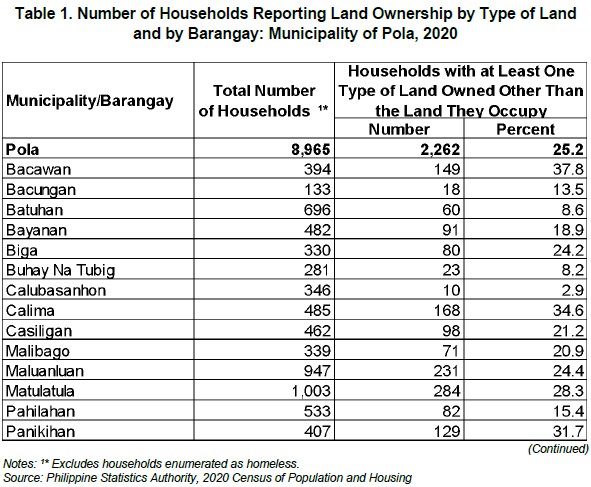
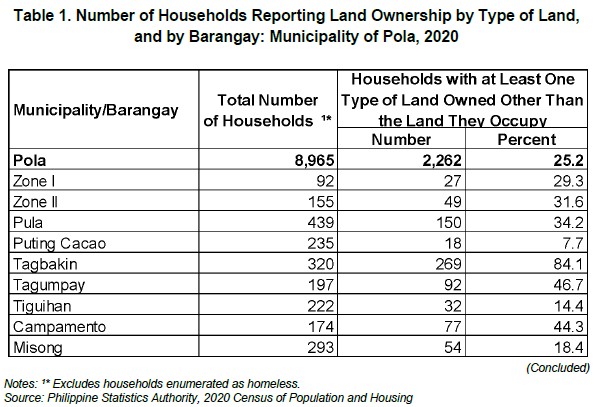
Among the 23 Barangays of Pola Oriental Mindoro, Barangay Tagbakin had the highest proportion of households with at least one type of land they owned other than the land they occupy, with 84.1 percent or 269 households. It was followed by Barangay Tagumpay with 92 households (46.7 percent), Barangay Campamento with 77 households (44.3 percent), Barangay Bacawan with 149 households (37.8 percent) and Barangay Calima with 168 households (34.6 percent), with at least one type of land they owned other than the land they occupy.
Meanwhile, Barangay Calubasanhon had the fewest proportion of household with at least one type of land they owned other than the land they occupy, with 10 households (2.9 percent).
21.4 percent households in Pola, Oriental Mindoro own’s agricultural land/s
Of the total 8,965 households, 1,922 households or 21.4 percent were reported to own agricultural land/s. Households that owned other residential land/s totaled 589 households or 6.6 percent while households that owned agricultural land/s acquired through the Comprehensive Agrarian Reform Program (CARP), as agrarian reform beneficiary reached 155 households or 1.7 percent and 9 households (0.1 percent) had members that owned other types of land/s.
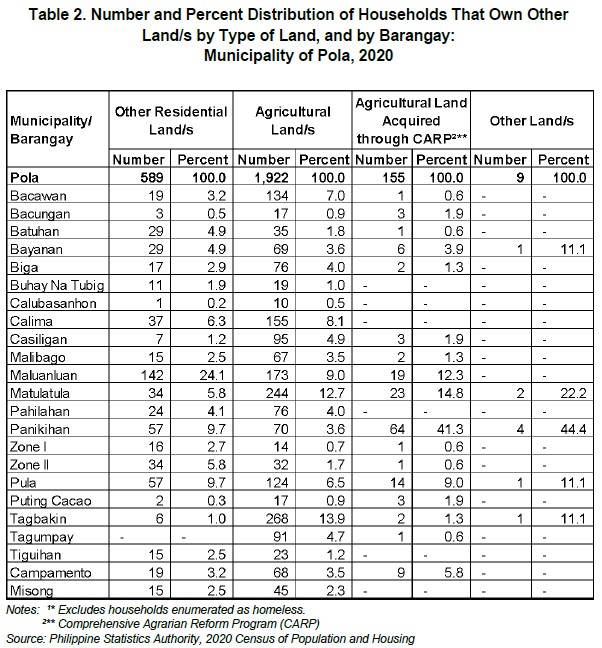
Barangay Maluanluan posts the biggest number of households that own residential land/s
Of the total 589 households, Barangay Maluanluan posted the highest number of households that own residential land/s with 142 or 24.1 percent in Pola, Oriental Mindoro, followed by Barangays Panikihan and Pula with 57 households (9.7 percent), each, Barangay Calima with 37 (6.3 percent) and Barangays Matulatula and Zone II with 34 households (5.8 percent), each, that own residential land/s.
Meanwhile, Barangay Tagumpay reported none in number of households that own residential lands in Pola, Oriental Mindoro.
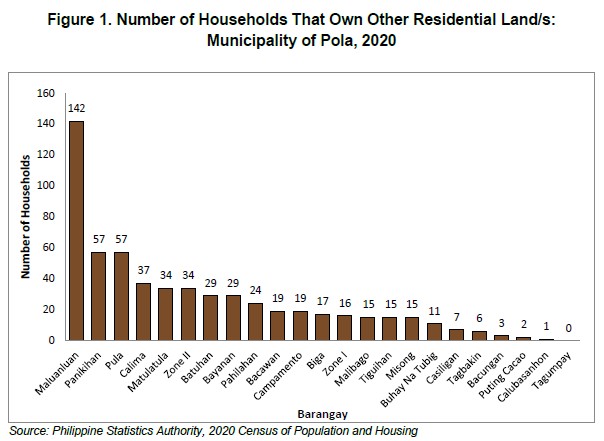
Barangays with the number of households that own agricultural lands
Barangay Tagbakin had the highest number of households that own agricultural lands with 268 households or 13.9 percent in Pola, Oriental Mindoro. It was followed by Barangay Matulatula with 244 households (12.7 percent) and Barangay Maluanluan with 173 households (9.0 percent).
On the other hand, Barangay Calubasanhon recorded the least total number, with 10 households which corresponds to 0.5 percent own agricultural land in the municipality of Pola, Oriental Mindoro.
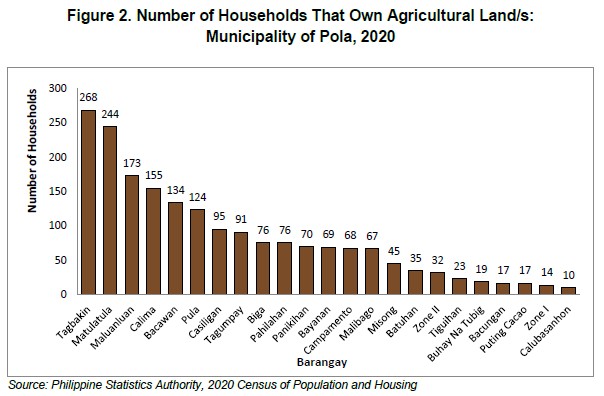
Barangays with the ownership of agricultural land/s acquired through CARP
The highest number of households that own agricultural lands acquired through the Comprehensive Agrarian Reform Program (CARP) in Pola, Oriental Mindoro was registered in Barangay Panikihan with 64 households or 41.3 percent. It was followed by Barangay Matulatula with 23 households (14.8 percent) and Barangay Maluanluan with 19 households (12.3 percent), Barangay Pula with 14 households (9.0 percent), Barangay Campamento with 9 households (5.8 percent), Barangay Bayanan with 6 households (3.9 percent), Barangays Bacungan, Casiligan and Puting Cacao with 3 households (1.9 percent), each, and Barangays Biga, Malibago and Tagbakin with 2 households (1.3 percent), each.
Meanwhile, Barangays Bacawan, Batuhan, Zone I, Zone II and Tagumpay recorded with one household (0.6 percent), each, that owned agricultural land/s acquired through the Comprehensive Agrarian Reform Program (CARP) in Pola, Oriental Mindoro.
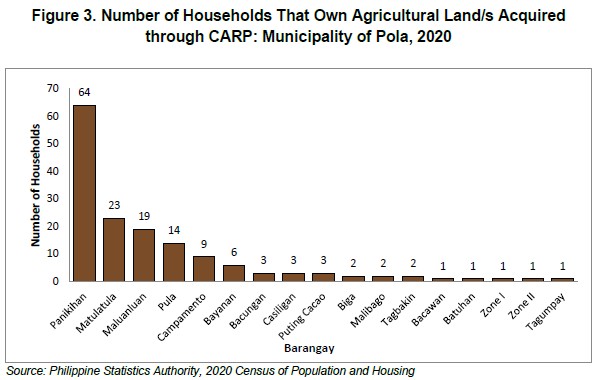
Barangays with the number of households that own other types of land
Barangay Panikihan recorded the highest total number of households that own other types of land with four households. Other lands include lands that are used for commercial, industrial, or recreational purposes. It was followed by Barangays of Matulatula with two households and Barangays Bayanan, Pula and Tagbakin with one household, each.
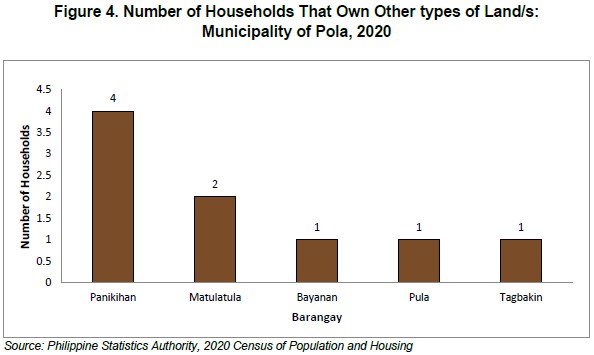
The statistics presented in this report were based on the information provided by the respondent or any responsible household member who may provide accurate answers to the questions and give correct information about the household. Moreover, the number of households in this report excludes households enumerated as homeless.
In the 2020 CPH, data on the land ownership were collected by asking the respondents, “Does any member of this household own the following?
1. Other residential land/s;
2. Agricultural land/s;
3. Agricultural land/s acquired through Comprehensive Agrarian Reform Program, as an agrarian reform beneficiary;
4. Other land/s.
CHARLYN ROMERO-CANTOS, PhD
(Chief Administrative Officer)
Officer-in-Charge
Oriental Mindoro Provincial Statistical Office
JAMF
TECHNICAL NOTES
The population and housing censuses in the Philippines are conducted on a “de jure” basis, wherein a person is counted in the usual place of residence or the place where the person usually resides. The enumeration of the population and collection of pertinent data in the 2020 CPH referred to all living persons as of 01 May 2020.
For land ownership in the 2020 CPH, the respondent was asked, “Does any member of this household own the following...?” This determines if the household has any member/s who own other lands aside from the one that the household is currently occupying. The data were collected using the CPH Form 2 (Common Household Questionnaire).
DEFINITION OF TERMS
Household is a social unit consisting of a person or a group of persons who sleep in the same housing unit and have a common arrangement in the preparation and consumption of food.
Agricultural Land/s refers to land/s devoted to or suitable for the cultivation of the soil, planting of crops, growing of trees, raising of livestock, poultry, fish, or aquaculture production, including the harvesting of such farm products, and other farm activities and practices performed in conjunction with such farming operations by persons whether natural or juridical and not classified by law as mineral land, forest land, residential land, commercial land, and industrial land.
Residential Land/s refers to All lands that have been identified and zoned as residential through the appropriate ordinance by the Local Government Unit (LGU) having jurisdiction over the area. These include residential lands within areas zoned as mixed residential and commercial or mixed residential and industrial (Source: RA 10023, Series of 2010).
Other Residential Land refers to residential lands that the household owns other than the one they are occupying.
Other Land/s include commercial lands, industrial lands, ancestral domains, and ancestral lands. The last two categories are distinguished from Torrens Title and other tenurial instruments granted by a government agency or by the court.
Agricultural land/s, acquired through Comprehensive Agrarian Reform Program, Agrarian Reform Beneficiary pertains to land ownership acquired through Emancipation Patent (EP) Holder, Certificate of Land Ownership Award (CLOA), and
Homestead Patent (HP), Leasehold Contract (LC).

